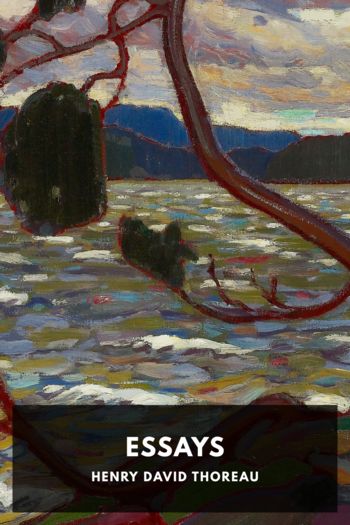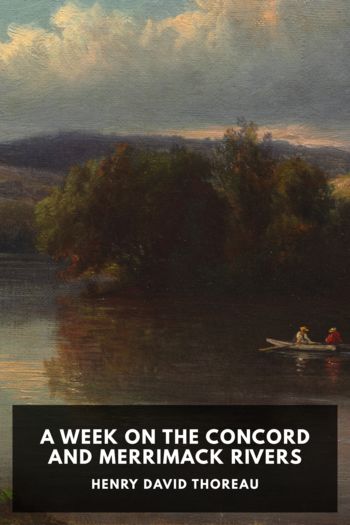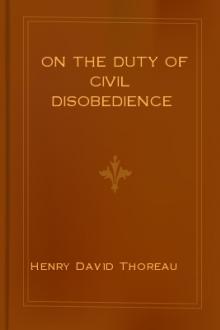Essays by Henry David Thoreau (feel good books .txt) 📕

Description
Though perhaps most famous for Walden, Henry David Thoreau was also a prolific essayist. Many of his essays touch on subjects similar to his famous book: long walks through nature, things found in moonlight that are invisible and unheard during the day, his preference for wild apples over domestic ones. In many ways he prefigured environmentalism, expressing his love for untouched nature and lamenting what the encroachment of man and cities were doing to it.
He also had strong opinions on many other subjects. One of his most famous essays, “On the Duty of Civil Disobedience,” was written as a result of his going to jail for refusing to pay several years’ worth of poll taxes. One of the primary reasons for his refusal was his holding the government in contempt for its support of slavery, and several of his other essays express support and admiration for John Brown, who thought to start a slave revolt when he attacked Harper’s Ferry in 1859.
Whether discussing trees in a forest, slavery, or the works of Thomas Carlyle, Thoreau’s essays are deeply personal and full of keen observations, often in poetic language. They give a sense of the man expressing them as being much more than the views being expressed.
Read free book «Essays by Henry David Thoreau (feel good books .txt) 📕» - read online or download for free at americanlibrarybooks.com
- Author: Henry David Thoreau
Read book online «Essays by Henry David Thoreau (feel good books .txt) 📕». Author - Henry David Thoreau
A village needs these innocent stimulants of bright and cheering prospects to keep off melancholy and superstition. Show me two villages, one embowered in trees and blazing with all the glories of October, the other a merely trivial and treeless waste, or with only a single tree or two for suicides, and I shall be sure that in the latter will be found the most starved and bigoted religionists and the most desperate drinkers. Every washtub and milkcan and gravestone will be exposed. The inhabitants will disappear abruptly behind their barns and houses, like desert Arabs amid their rocks, and I shall look to see spears in their hands. They will be ready to accept the most barren and forlorn doctrine—as that the world is speedily coming to an end, or has already got to it, or that they themselves are turned wrong side outward. They will perchance crack their dry joints at one another and call it a spiritual communication.
But to confine ourselves to the maples. What if we were to take half as much pains in protecting them as we do in setting them out—not stupidly tie our horses to our dahlia-stems?
What meant the fathers by establishing this perfectly living institution before the church—this institution which needs no repairing nor repainting, which is continually enlarged and repaired by its growth? Surely they
“Wrought in a sad sincerity;
Themselves from God they could not free;
They planted better than they knew;—
The conscious trees to beauty grew.”
Verily these maples are cheap preachers, permanently settled, which preach their half-century, and century, ay, and century-and-a-half sermons, with constantly increasing unction and influence, ministering to many generations of men; and the least we can do is to supply them with suitable colleagues as they grow infirm.
The Scarlet OakBelonging to a genus which is remarkable for the beautiful form of its leaves, I suspect that some scarlet-oak leaves surpass those of all other oaks in the rich and wild beauty of their outlines. I judge from an acquaintance with twelve species, and from drawings which I have seen of many others.
Stand under this tree and see how finely its leaves are cut against the sky—as it were, only a few sharp points extending from a midrib. They look like double, treble, or quadruple crosses. They are far more ethereal than the less deeply scalloped oak-leaves. They have so little leafy terra firma that they appear melting away in the light, and scarcely obstruct our view. The leaves of very young plants are, like those of full-grown oaks of other species, more entire, simple, and lumpish in their outlines; but these, raised high on old trees, have solved the leafy problem. Lifted higher and higher, and sublimated more and more, putting off some earthiness and cultivating more intimacy with the light each year, they have at length the least possible amount of earthy matter, and the greatest spread and grasp of skyey influences. There they dance, arm in arm with the light—tripping it on fantastic points, fit partners in those aerial halls. So intimately mingled are they with it, that, what with their slenderness and their glossy surfaces, you can hardly tell at last what in the dance is leaf and what is light. And when no zephyr stirs, they are at most but a rich tracery to the forest-windows.
I am again struck with their beauty, when, a month later, they thickly strew the ground in the woods, piled one upon another under my feet. They are then brown above, but purple beneath. With their narrow lobes and their bold deep scallops reaching almost to the middle, they suggest that the material must be cheap, or else there has been a lavish expense in their creation, as if so much had been cut out. Or else they seem to us the remnants of the stuff out of which leaves have been cut with a die. Indeed, when they lie thus one upon another, they remind me of a pile of scrap-tin.
Or bring one home, and study it closely at your leisure, by the fireside. It is a type, not from any Oxford font, not in the Basque nor the arrow-headed character, not found on the Rosetta Stone, but destined to be copied in sculpture one day, if they ever get to whittling stone here. What a wild and pleasing outline, a combination of graceful curves and angles! The eye rests with equal delight on what is not leaf and on what is leaf—on the broad, free, open sinuses, and on the long, sharp, bristle-pointed lobes. A simple oval outline would include it all, if you connected the points of the leaf; but how much richer is it than that, with its half-dozen deep scallops, in which the eye and thought of the beholder are embayed! If I were a drawing-master, I would set my pupils to copying these leaves, that they might learn to draw firmly and gracefully.
Regarded as water, it is like a pond with half a dozen broad rounded promontories extending nearly to its middle, half from each side, while its watery bays extend far inland, like sharp friths, at each of whose heads several fine streams empty in—almost a leafy archipelago.
But it oftener suggests land, and, as Dionysius and Pliny compared the form of the Morea to that of the leaf of the Oriental plane-tree, so this leaf reminds me of some fair wild island in





Comments (0)